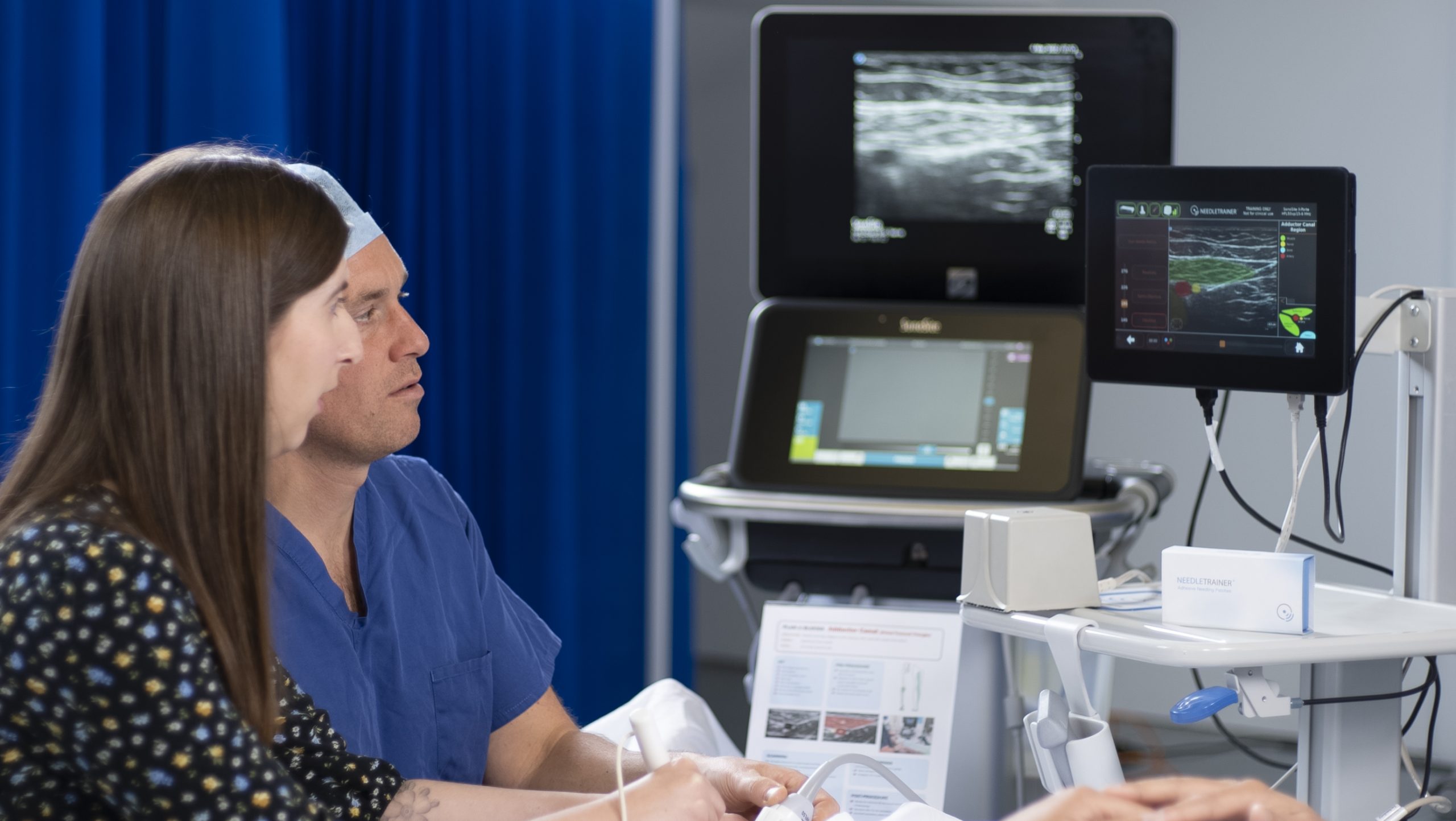
UCLH invests in NeedleTrainer and ScanNav Anatomy PNB
University College London Hospital (UCLH) has invested in Intelligent Ultrasound’s NeedleTrainer and ScanNav Anatomy Peripheral Nerve Block (PNB), to expand training opportunities for regional anaesthesia.
A central London teaching hospital, UCLH currently uses anatomical ‘phantoms’ as part of its training program for early needling skills, along with monthly nerve block teaching sessions and in-theatre training. However, during the pandemic many training opportunities for regional anaesthesia were limited which compelled UCLH to invest in new technologies to enhance their training program for regional anaesthesia.
Dr Zeshan Bhatti came to UCLH in February 2021 to complete the regional anaesthesia fellowship but found that during the second wave of the pandemic, the opportunities for practical training were limited due to the large reduction in theatre case load necessitated by safe practice around Covid 19, as well as redeployment of trainees to the ICU.
He spoke to lead consultant anaesthetist Dr Simeon West about the potential that employing these new technologies could add to the training program. “We were talking about how the pandemic has massively impacted regional anaesthetic training and whether there were any other things that we could do.” Dr Simeon West, MBChB FRCA
Something like NeedleTrainer offers the opportunity to do a block in a protected safe environment and therefor maximises the opportunities that we can get in terms of getting experience
Dr Zeshan Bhatti
“Regional anaesthesia is something that we build on as we go up in our training and doing those first blocks can be quite daunting, and so something like NeedleTrainer offers the opportunity to do a block in a protected safe environment and therefore maximises the opportunities that we can get in terms of getting experience in our needling technique and performing these blocks successfully.” Dr Zeshan Bhatti
NeedleTrainer connects to the ultrasound machine to simulate needling non-invasively on a live participant, using a retractable needle and augmented reality technology. This enables trainees to develop hand-eye coordination, optimum positioning, and accuracy in ultrasound-guided needling in a safe but realistic, clinical environment.
“Up till now there hasn’t really been any way we can simulate, outside of phantoms, on real patients, and that is probably where I think the strength of NeedleTrainer comes in. I can show somebody a block, they can practise and then I can perform the block and we get multiple training outcomes from each block that we do.” Dr Simeon West, MBChB FRCA
UCLH invested in Intelligent Ultrasound’s classroom-to-clinic package which includes ScanNav Anatomy PNB, to further enhance the learning pathway for regional anaesthesia.
They can use ScanNav Anatomy PNB to give them a bit of confidence that they are identifying anatomy that they think they are
Dr Simeon West, MBChB FRCA
“The strength of the ScanNav will be with people who are in the ‘next stage’ where they have done some NeedleTrainer work and are better at their needling skills but, they still need some training wheels in terms of the ultrasonography side and sono-anatomy identification. And also, for some of my colleagues who are infrequent users of regional anaesthesia, where they can use ScanNav Anatomy PNB to give them a bit of confidence that they are identifying anatomy that they think they are” Dr Simeon West, MBChB FRCA
ScanNav Anatomy PNB provides a real-time colour overlay of key sono-anatomical structures during training and clinical practice of regional anaesthesia. Developed with leading experts in regional anaesthesia, ScanNav Anatomy PNB is a CE marked medical device to support clinical practise of regional anaesthesia on patients.
“NeedleTrainer augments our practise, our learning, especially as trainees when we are getting that needling right, and then moving onto the ScanNav and using a real needle, I think this will be a next step in term of learning, using something more hi-tech in addition to [the tools] we already have. It’s an additional tool to make us better as we go through our training program.” Dr Zeshan Bhatti
the more that we can do of this, the more we are going to be able to produce people that are confident by the end of training
Dr Simeon West, MBChB FRCA
“The big challenge ahead is the change in the royal college curriculum. We’ve seen a change from regional anaesthesia being a ‘it would be nice if you can do it’ in addition to the curriculum, to a core part of the curriculum. So whereas before we would have people coming in with more specialist interest modules who would then be able to perform regional anaesthesia by the end of their training, actually now we need to do this for everyone who completes their training, so by the time we are reaching ST7 equivalencies people should be able to perform a block for basically every body part.
There are limited opportunities to do regional anaesthesia, we can’t create a patient who wants it, we can’t create a list that it’s necessary for, but utilising simulation and especially hi-fidelity simulation like this, enables us to make a training opportunity of things that potentially weren’t an actual block. And the more that we can do of this, the more we are going to be able to produce people that are confident by the end of training. Because we have to be aware that we are stepping up the game in terms of numbers.” Dr Simeon West, MBChB FRCA
To find out more about how we can support your training program for regional anaesthesia, get in touch: